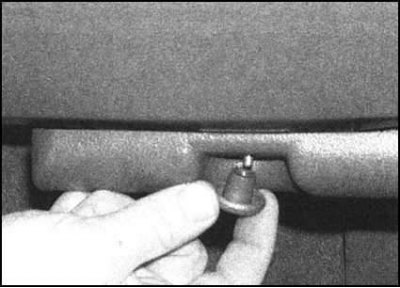Circuit breakers
Most of the fuses are placed together with the relay in a special mounting block installed under the instrument panel in the passenger footwell. Fuses of some of the additional systems (ABS, K/V) can be installed in separate holders fixed in the left side of the engine compartment. On diesel models, the fuses for the preheating system and the cooling fan can also be located in the vehicle's engine compartment.
In order to provide access to the fuses, unscrew the mounting clip and, turning it with a book, release the mounting block from the instrument panel. The list of fuses is given in the last Section of this Chapter. To access the fuses located in the engine compartment, open the hood cover, release the latches and the cover from the corresponding holder.



To replace a fuse, first switch off the relevant circuit/switch off the ignition. Then grab the body of the knocked-out fuse with special tongs fixed in the cover of the block and pulling it vertically upwards, remove it from the holder terminals. A failed fuse is easily identified by a melted or burnt conductive jumper.
Never replace a blown fuse with a higher rated fuse (by current strength) loads. It is extremely bad practice to restore a failed fuse by bridging its contacts with metal foil.
If the replacement fuse fails immediately after power is applied to the circuit, then there is a short circuit in the circuit, the cause of which should be identified and eliminated. If the fuse under test is used to protect several electrical circuits at the same time, try to identify the faulty circuit by turning on each of the monitored circuits in turn, thereby excluding known good ones.
Relay wiring diagram

1 - Winding; 2 - Moving contact (anchor); 3 - Contacts
A relay is an electromechanical switch used primarily in power circuits. The electrical circuit of a relay of a typical design is shown in the illustration.
Most of the relays used on the car are placed in a common mounting block with the fuses. Additional relays (relay type of diesel engine preheating system) located in the engine compartment.
In order to provide access to the relay, unscrew the mounting latch and, turning it with a book, release the mounting block from the instrument panel.
If there is a suspicion that the failure of any of the electrical circuits is associated with the failure of its control relay, turn on the corresponding system - a serviceable relay should make a distinctly audible click when power is applied to it. If a click is heard, then the cause of the failure is a malfunction of the working component itself, or a failure of the electrical wiring. Otherwise, there is either a power failure or the relay itself is faulty. The state of the relay is checked by substituting a known good one in its place. At the same time, one should not forget that the external similarity of two relays is not at all a guarantee of the identity of the principle of their operation.
To replace a relay, first turn off the relevant electrical circuit. The relay can then be easily removed by pulling it out of its receptacle. Replace the removed relay with a new one with the appropriate operating parameters.
Turn signal/alarm breaker

1 - Winding; 2 - Contact; 3 - Contact; 4 - Thread; 5 - Fuse 15 A; 6 - Fuse 8 A; 7 - Battery; 8 - Ignition switch; 9 - Alarm switch; 10 - Switch for direction indicators; 11 - Indicator lamps for direction indicators / alarms; 12 - Turn signal lamps
The connection diagram for the turn signal/alarm switch is shown in the illustration.
